Chimney sweeping and stove maintenance are essential annual services. They ensure your whole flue system is safe and effective and continue to be in good working order.
If you’ve just moved into a house and there is no service record, or your stove isn’t working correctly, it’s a good idea to get your stove serviced and flue swept.
The best time of year to get this service done is when the heating season is finished – typically from spring into the summer months. Demand for sweeping is high in winter and you’ll likely have to wait for any sweep to be available. Our focus is on installations during the winter months. Don’t settle for second best: get Blazing Burners to sweep and service your flue and stove.
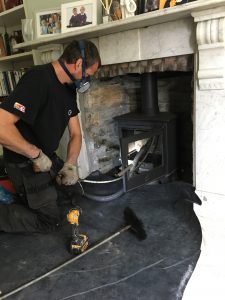
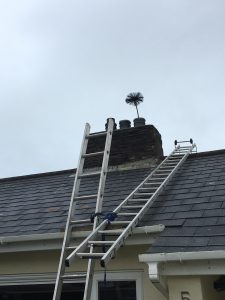
The legal stuff
Your household insurance will demand your flue is swept annually to honour your contract. The manufacturers of your flue and stove will request they are serviced annually as part of the conditional warranties.
Why should chimneys be swept?
The main reason for “chimney sweeping” is to prevent the build-up of soot and tar-like substances that are waste products from combustion. These by-products are toxic and flammable and need removing. They can quickly build up and cause blockages within your flue. If they are not removed, you are risking the chance of having a chimney fire and Carbon Monoxide (CO) poisoning which could be fatal.
If your flue does not have a bird guard on the terminal, your flue could get blocked if birds nest within your flue.
Why are stoves serviced?
Your stove should be cleaned and serviced to improve and maintain its longevity ensuring that it is working as well as it should be and is still safe to use. Having the stove checked, cleaned, and parts replaced enables the stove to perform at its best and air quality to be maintained – as per the Clean Air Strategy (Jan 2019).
Chimney sweeping – Rotary power sweeping
Flues can be cleaned by using a variety of techniques. Sticking a brush on the end of a rod, then vigorously moving it back and forth is not an effective or safe technique – this will likely tear your liner or damage your flue. There are different sizes and types of brushes and rods. There are also various techniques that are used to remove the waste products from your flue effectively. Knowing what method and what equipment should be used for your particular “sweep” will prevent damage to your flue.
We have invested in what we believe to be the best power sweeping kit available – Rotary Power Sweeping. It is a dual lock system and is extremely effective at cleaning flues. There are different rod depending on what flue system you have. There are also different brushes and rod end connections depending on your system and what needs removing or clearing. The rods are attached to a drill, and the drill spins the rods and brushes/terminals making for a much more effective cleaning method.
On completion, all waste will be removed, put in a bin bag and placed it in your refuse bin outside ready for collection.
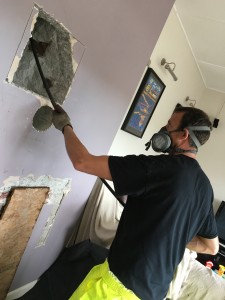
Stove service
Every year a stove should be completely disassembled, checked and cleaned thoroughly, before being reassembled. Consumable components should all be checked and replaced if necessary, include spigots and blanking plates, rope seals, firebricks, handles and glass doors. If parts are replaced, they will be chargeable.
We are aware that many companies don’t perform this part of a service, yet we believe that servicing the stove is just as crucial as sweeping the flue. When we attend a new enquiry to a stove sweep, the flue may have had attention, but the stove has often been neglected. This is a dangerous practice, and we’ve seen it too often in this industry. We intend to change that. The flue and stove work hand in hand. They should both be serviced, not just the flue system.
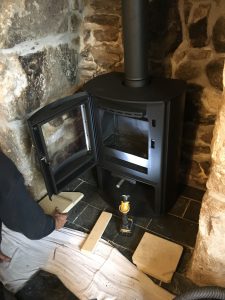
The Blazing way
Installations are our bread and butter. We handle stoves and fit flue systems all the time. With each installation, we completely disassemble the stove and then put it back together. It’s second nature to us. We know how vital the stove is and how to fix it if anything goes wrong…too much draw, not enough draw, loose blanking plate, cracked firebricks…
On each of our installations, we use what we consider to be the industries best materials. We want to ensure that they are kept in pristine condition and that the stove we fitted gives you many years of safe pleasure and looks great year after year.
We carry most stove materials with us. This allows us to perform the necessary repairs on the spot. Standard square and rectangular vermiculite bricks can be cut on site from a vermiculite sheet we carry. We also carry various types of fire-rope and have fire cement, sealants and specialised cleaning products at hand.
Where we can, your glass will be cleaned and brought back to life.
If your stove needs repainting, we’ll do this – also as part of the service. We carry satin black paint as standard, but if your stove is a different colour, we can supply a can of paint (chargeable) and use this; it should be enough for about 3-5 years of services, and it will be left with you for safe-keeping.
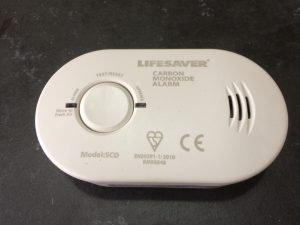
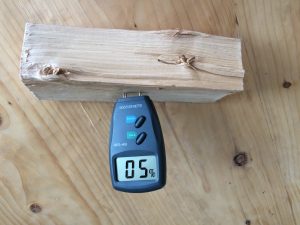
We’ll check your CO alarm, making sure it is working, test your wood to make sure it is seasoned and on completion issue you with a certificate detailing everything that we have done and what is recommended for the next service.
Your stove and flue system will look and perform like new again.
If your stove has specific vermiculite bricks, and baffles, these will need ordering in. The same applies to damaged glass. Returning to fit these components will be charged accordingly and can be quoted for.
If your flue system is a twin wall flue and is fitted to the side of your property, the brackets can also be checked. We recommend this be done every 3 years. This service is chargeable, as it will involve 2 people and ladder access. We will be able to quote for this depending upon your flue system.
If you are doing something wrong – misusing the stove, burning the wrong fuels – there will be tell-tale signs which we can spot. We’ll be able to help you correct it with freely given information and advice – often linked to various industry regulated and approved websites.
If your stove is not in use, the air vents should be left open, and your door slightly ajar to encourage airflow within the flue and stove preventing moisture build up and rusting.
To complement our exemplary service standards, we created our Three-Year Service Agreement, which many of our customers have signed up for to make the sweep and service process simple and affordable.
Three-Year Service Agreement
If you have an open fire or a stove, we offer a Three-Year Service Agreement and invite you to participate in this incredible deal. You get a significant discount on the standard charge, and the price remains the same for the 3 years that you are in the agreement; therefore you will save money. Once we have agreed to a date, we remind you twice before each service. So overall, it becomes a job you don’t have to think about.
Furthermore, by having a full yearly service, you will be ensuring that your entire flue system works safely and effectively and that air quality is not compromised.
If you would like to participate in this promotion simply fill out the contact form by clicking here and let us know that you are interested in the “Three-Year Service Agreement”. We’ll take care of the rest and organise a schedule that works for you. Don’t worry if we haven’t fitted your stove; we’ll inspect your stove and if it’s safe to continue using it, we’ll set up the agreement and perform the service.
Pricing guide
Service Normal price 3-Year Service Agreement price
Chimney sweeping (stove) £60.00 £50.00
Chimney sweeping (open fire) £80.00 £70.00
Service (sweep and stove service) £90.00 £70.00
NB All prices are subject to 20% VAT
Other services
Bird nest removal: £60.00 per hour
Consumable parts: Varies depending on parts
CO alarm supply and fit: £45.00 (supply only: £25)
Return visits to fit parts: £25.00 (within a 40-minute drive)
Cowl supply and fit: £80.00 upward
NB All prices are subject to 20% VAT
Bird nest removal
Most birds tend to build nests in April and will stay there for about 3-4 months, laying their eggs, and rearing their fledglings, until they are ready to leave the nest.
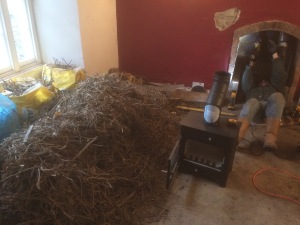
Specific to chimneys, Jackdaws are our biggest concern as they like to nest within a warm, dry flue, which is typically about 3 metres down from the pot. You would know that they are starting to nest as you would notice twigs coming down the flue and you would be able to hear them chatting away. You would also be able to see their busy activity if you were to look outside as these master builders enter and exit your flue!
If you haven’t taken measures to fit a bird guard to your flue before them nesting, you would have to wait until the fledglings have left the nest in July before being able to do anything about it (as per The Wildlife and Countryside Act – 1981).
Only once the nest has been vacated are we then permitted to remove them.
As Jackdaws are creatures of habit, they’ll return every year until you do something about it. If a jackdaw has been allowed to nest for consecutive years, the nest can be substantial and require some time to remove. Therefore, following an initial call out or sweeping fee, removing bird nests is charged on an hourly rate. Our rotary power sweeping kit allows us to remove nests rapidly and effectively.
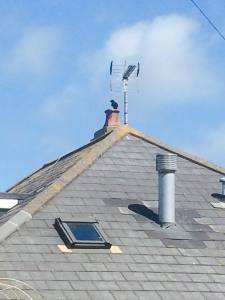
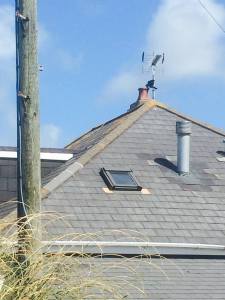
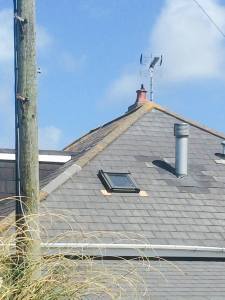
CO alarms
Carbon monoxide (CO) is known as a silent killer. It is odourless, invisible and deadly gas.
CO can be released when burning fuel. If you have an open fire or a stove, you should have a CO alarm fitted. The placement of the alarm is precise.
We can supply and properly fit CO alarms for £45.00 + VAT. It might well be the best money you’ll ever spend! Our CO alarms conform to building regulations (ADJ 2010) and have a battery shelf life of 10 years.
Here’s what HETAS have to say about Carbon Monoxide
Cowls
Cowls are used to terminate a flue. It is a significant part of a chimney system, and every flue should have a cowl fitted. Your flue system and any issues you may have with it will help determine what type of cowl you should have installed.
The simplest cowls will close off a redundant flue. For example, if you have a disused chimney and it is not capped correctly, it will be allowing rain or wildlife to enter. In this instance, we can supply and fit a cowl that will blank off the unused flue yet allow a small amount of air to circulate within your chimney thus preventing condensation and damp issues. We charge £80.00 + VAT for this service providing we can access your pot from ladders.
If you have a “live” flue, there are many types of cowls available. If you have issues with birds nesting, a bird guard cowl can be fitted. If there is too much draw from your flue and you can’t control your fire, meaning that you are burning too much fuel, an anti-downdraught cowl can be fitted.
In some cases, you might not even have a chimney pot.
Whatever the problem, we can provide affordable solutions to resolve these issues. The price will be dependent on what you require. We strongly suggest and advise you choose a cowl that is made from quality stainless steel and not the cheaper galvanised steel. We live by the sea and are subject to corrosion more so than inland areas. Please contact us here for more information.
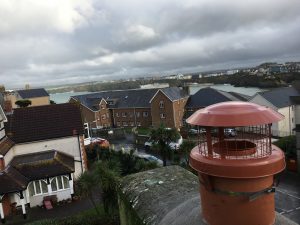
Fireplace preparation
We ask you to clear the fireplace including any ornaments on the hearth and mantelpiece so that we have clear access in which to work from.
We prepare the fireplace using a combination of dust sheets and plastic sheets. We ensure the soot-fall and ash are contained within the flue and stove. However, if your flue has not been swept for quite some time, there may be a large amount of soot-fall or debris. We will always do our best within our capabilities to contain this. If you are concerned about your furniture and want to sheet this up as an extra precaution, please feel free to do so. We always carry excess dust-sheets with us if we think that your flue will be troublesome once we have started.
How often should I have my stove serviced and flue swept?
Your stove should be serviced annually.
Your flue should be swept at least once a year. Most schools of thought are that if you are using your stove for 3 solid months, then you should be getting it swept at this point.
However, the actual amount of times it is swept within a year will depend on the following:
- What fuel you burn
- How you burn the fuel
- How often you use the stove
-
What fuel you burn
From our experience of sweeping countless flues and servicing stoves, we have found that the type of fuel you burn will help determine how much soot and ash will be produced in your stove and flue. Other waste products will also be produced. The amount of these products produced differs considerably from one fuel to another.
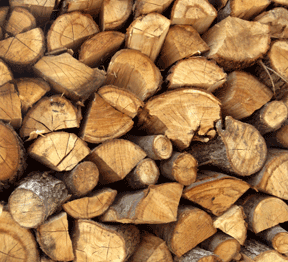
Well seasoned or kiln dried logs. The moisture content must be below 20%
Soot is more harmful and toxic that ash. For example, you can use ash to clean your glass and even your hands. However, you wouldn’t want to use soot for this purpose. Soot is more solid and black in appearance. If your wood has high water content, the water can bind with the soot and create a tar-like substance called creosote. This can be sticky and crystal-like. It sticks to flues and reduces the size of them making them a hazard. Furthermore, it can be very flammable. Thus, creosote building is a leading cause of chimney fires.
Burning a poor-quality smokeless fuel will produce an incredible amount of ash & soot. Even a good quality smokeless fuel can produce copious amounts of ash and soot. On the other hand, if you use wood as your only fuel and it is very well seasoned (under 15% water content) the amount of soot and ash will be far less. The species of wood will also determine how much waste will be generated. For instance – if you burn kiln-dried ash, you will hardly notice any debris in the bottom of your stove.
Click on the links below for more “usefuel” information.
-
How you burn the fuel
Learning how to burn fuel correctly will ensure you get the most out of it – thus generating more heat and less waste, improving air quality.
Smouldering a fire and/or banking it overnight is considered bad news and old school. Those days are gone. We have learnt there are two ways to release heat from the fuel. One way is to actually burn the fuel so that the solid fuel upon combustion releases heat. This accounts for about 20% of the actual heat generated.
The second way generates the majority of heat and is produced from burning the volatile gasses released from solid fuel. Modern stoves are manufactured in such a means whereby these gases are allowed to stay within the combustion chamber until they can be burnt and converted to heat. However, this process requires a flame.
Consequently, when your stove is in use, you should always have a flame present. This will help ensure that your fuel is fully combusted, the heat output is high, a good draw is created, waste products are kept to a minimum, and your stove and flue are maintained in the best possible condition.
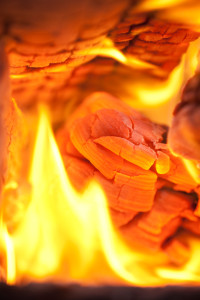
Always have a flame to burn the volatile gasses
Don’t clog up your stove and flue – have a flame! Let the stove do its job, sit back and enjoy watching the flame dance away in your Blazing Burner.
Click on the links below for more useful information.
-
How often you use the stove
The more you use the stove, the more waste products you will produce. However as explained above, this will also depend on what fuel you use and how well you burn it.
A simple rule of thumb to follow would be if you have a fire 5 nights a week for approximately 4 hours, and this continues for 3 months – get the flue swept!
Get in Contact
If you want to talk to us or use any of our services ranging from a flue sweep to a full stove service, or just to fit a cowl or a CO alarm, please get in contact with us here.
